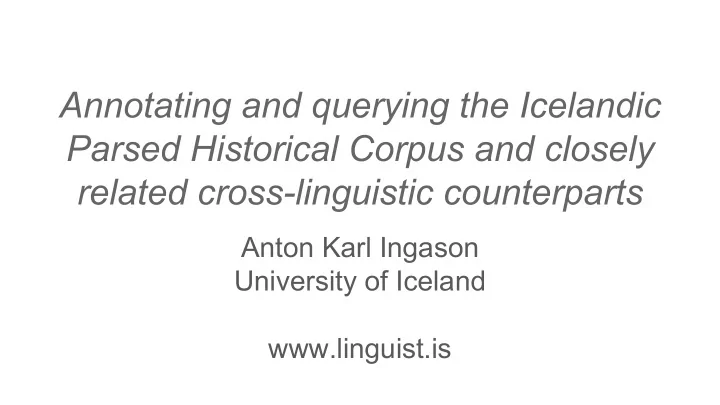

Annotating and querying the Icelandic Parsed Historical Corpus and closely related cross-linguistic counterparts Anton Karl Ingason University of Iceland www.linguist.is
Outline ● Introduction to the Icelandic Parsed Historical Corpus (IcePaHC) ● Our annotation process and software. ● PaCQL query language and online search engine ○ A new type of treebank search for the Digital Humanities. ○ Ingason, A. K. (2016). PaCQL: A new type of treebank search for the digital humanities. Italian Journal of Computational Linguistics , 2(2), 51-66. ○ Google or look up on: www.linguist.is/papers
Introduction to IcePaHC ● IcePaHC is a treebank, annoted according to the annotation scheme of the Penn Parsed Corpora of Historical English (for quantitative diachronic syntax) ○ Phrase structure annotation. A growing family of similar treebanks. ○ Minimum changes for Icelandic-specific properties. ○ Often the same unmodified query works well across treebanks in this tradition. ● Joel Wallenberg, Eiríkur Rögnvaldsson, Einar Freyr Sigurðsson and Anton Karl Ingason. ● Ca. 1.000.000 words of manually corrected parses. ● Spans the period 12th-21st centuries ○ All those centuries are included. ○ Includes narratives and religious texts from throughout this period. ● All raw data freely available under an open source license. ○ The annotation itself was carried out in an open Github repository.
Example tree ● Format: Labeled bracketing, UTF-8 plain text. ● Documentation: http://www.linguist.is/icelandic_treebank/
Annotald annotation software ● Website: https://annotald.github.io/ ● Annotald was originally developed by AKI as part of the IcePaHC project but has since been improved considerably and maintained by Aaron Ecay. ● We initially used software that displayed trees like trees and had a more traditional graphical user interface. ○ This turned out to slow us down so we wrote our own system. ● Design: ○ The hierarchy extends from left to right (not top down). ○ Left hand never leaves the keyboard. All shortcuts are on the left side of the keyboard. ○ Right hand never leaves the mouse. The mouse is used to select and move things. ● License: GPL. Code available on Github.
Screenshot
Annotation speed
PaCQL - Parsed Corpus Query Language ● Most recent addition to our tools. ● Why not use existing tools? ○ There are many useful tools out there that you should use if you like them. ○ We wanted the right combination of a fast indexed search engine and powerful coding queries as typically used in quantitative diachronic syntax. ○ The language should make sense to historical syntacticians -- the way CorpusSearch does. ● Emphasis on output for syntacticians when using web search: ○ Practical visual features (color coding etc.) ○ Can download coding results as a .tsv file (for R, SPSS, Excel, ...) ○ Automatic plotting of the dependent variable over time. ○ Summary reports per centuries and per individual texts.
PaCQL - basic syntactic relationships ● idoms : immediately dominates ● idomsonly : immediately dominates x and nothing else ● idomsfirst : immediately dominates the leftmost child x ● idomslast : immediately dominates the rightmost child x ● doms : dominates at an arbitrary depth ● sprec : sisterwise precedence ● precedes : precedence regardless of embedding ● hassister : sisterhood ● sameindex : A has the same index as B
PaCQL - special relationships ● haslabel : match node label ● domswords : match nodes dominating N orthographic ● words ● domswords< : match nodes dominating less than N words ● domswords> : match nodes dominating more than N words ● idomslemma : POS-tag has child that has a specific lemma
PaCQL - special relationships ● haslabel : match node label ● domswords : match nodes dominating N orthographic ● words ● domswords< : match nodes dominating less than N words ● domswords> : match nodes dominating more than N words ● idomslemma : POS-tag has child that has a specific lemma
PaCQL - text level meta coding ● text textid : id of the text ● text year : (estimated) year the text was written ● text century : century the text was written ● text genre : main genre of the text ● text subgenre : subgenre of the text ● text postnt : 0 if written before New Testament translation, 1 otherwise ● text texttrees : total number of trees in the text ● text meantreewords : mean number of words per tree in the text ● text mediantreewords : median number of words per tree in the text ● text meanwordletters : mean number of letters per word in the text ● text lexicaldiversity : type frequency of word forms divided by the ● totalnumber of words in the text
PaCQL Tree level meta coding: ● tree treeid : unique id for the tree ● tree treewords : number of words in the tree Node level meta coding: ● node label A : the label matched by A ● node nodestring A : the string of leafs dominated by A ● node nodewords A : the number of words dominated by A
The software ● The search engine is written in Python ● Fast in-memory index cuts down waiting time. ● Server: Pyro 4 ● Web interface (uses Django/JQuery etc.): ○ www.treebankstudio.org
Example ● Evolution from object-verb (OV) to verb-object (VO) word order in Icelandic. (1) a. She will the bread eat. (OV) b. She will eat the bread. (VO) See treebankstudio.org : ● Documentation ● Syntax ● Results (export to .tsv for R/SPSS/Excel etc.) ● Summary reports ● Stability
Plans ● Make the system available to the users of other treebanks. ○ Let us know if you are interested! ● Release the PaCQL search engine under a free and open source ● software license. ● The output: ○ Offer more visualized and interactive output types. ○ Provide tools for more sophisticated analysis that now is dependent on other software, like R or Excel. ● More advanced search functionality. ● Improve user interface.
Recommend
More recommend